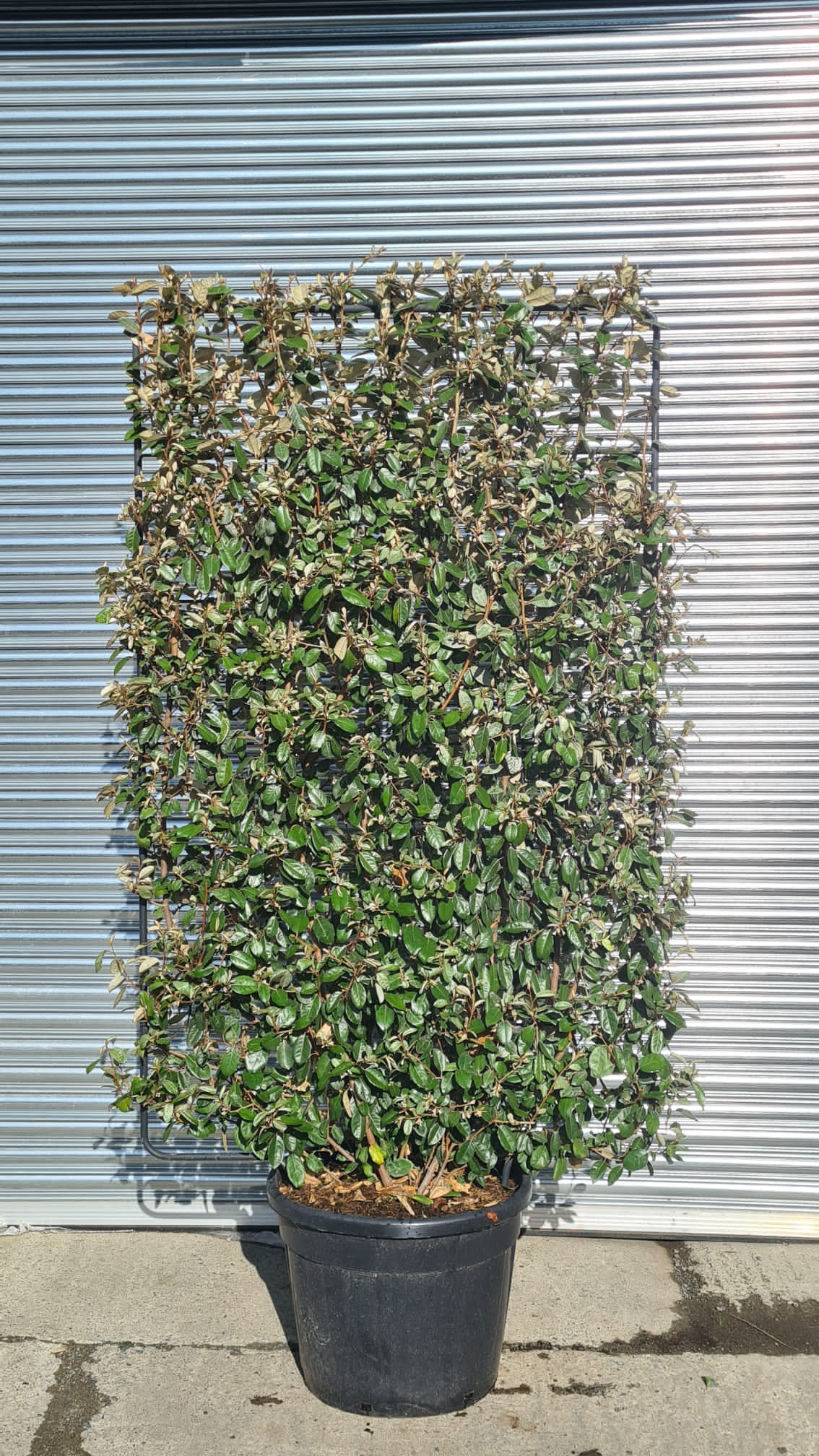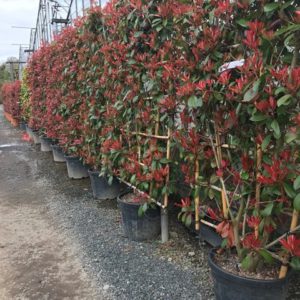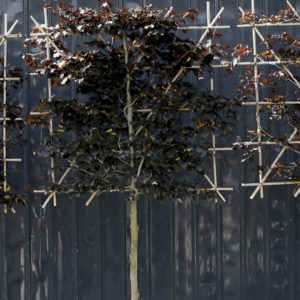Elaeagnus ebbengei ‘compacta’ Espalier – Full Frame
Price range: €130.00 through €525.00
Frequently Bought Together


Description
Quick Facts
- Common Name: Compact Oleaster Espalier, Compact Elaeagnus Espalier
- Botanical Name: Elaeagnus × ebbingei ‘Compacta’
- Plant Type: Evergreen shrub (trained as espalier)
- Mature Height: 1.5-2.5m (as trained espalier)
- Mature Spread: 1.5-3m (depending on training pattern)
- Flowering Period: October to November
- Flower Colour: Creamy-white, intensely fragrant
- Foliage: Glossy dark green leaves with silvery undersides, year-round coverage
- Hardiness: RHS H5 (hardy)
- Soil Requirements: Well-drained, tolerates most soil types
- Aspect: Full sun to partial shade
- Maintenance: Moderate to high (requires regular training and clipping)
Description
Experience the sophisticated beauty of Elaeagnus × ebbingei ‘Compacta’ presented as expertly trained espaliers, bringing exceptional space-saving elegance, year-round screening, and surprise autumn fragrance to gardens with its distinctive flat-trained form and shimmering silvery foliage. This outstanding evergreen shrub offers remarkable qualities—glossy dark green leaves with striking silvery-white undersides creating shimmering two-tone effect and elegant texture against walls and fences, expertly trained flat espalier form with horizontal tiers creating living architectural screens that maximize vertical space whilst minimizing depth making this perfect for narrow borders and tight spaces, intensely fragrant creamy-white flowers in autumn filling the air with sweet perfume when few other plants bloom, and exceptional adaptability thriving in coastal conditions, urban pollution, poor soils, and challenging sites making this one of the toughest architectural evergreens, making this one of the finest choices for creating space-saving elegance, year-round screening, autumn fragrance, and architectural presence in narrow borders, against walls, and in contemporary gardens.
Throughout the year, this captivating espalier displays its characteristic glossy dark green leaves measuring 6-8cm long with smooth edges and a leathery texture. The leaves have striking silvery-white undersides covered in tiny scales that catch the light creating beautiful shimmering effect, especially when the wind moves through the foliage or when viewed from below. The two-tone foliage creates elegant depth and interest against walls, fences, or freestanding frames. The leaves are held on branches that have been expertly trained into horizontal tiers along a supporting framework, creating the distinctive flat espalier form measuring 1.5-2.5m tall and 1.5-3m wide (depending on the training pattern—typically 3-5 tiers). The overall effect is formal, architectural, and space-efficient. In autumn (October-November), the plant produces its most enchanting feature—masses of small tubular creamy-white flowers measuring 1cm long that nestle within the foliage but announce their presence with intensely sweet fragrance reminiscent of gardenias or jasmine. The perfume is powerful and carries on the air—one of the most delightful autumn surprises in the garden, especially appreciated when trained near seating areas, pathways, or windows. The flowers are followed in spring by small oval orange-red fruits measuring 1-2cm long that are edible but astringent. The expertly trained espalier form provides instant architectural structure—the flat form maximizes screening and visual impact whilst taking up minimal depth, perfect for narrow borders, courtyard gardens, and contemporary landscapes.
This popular hybrid is a cross between Elaeagnus macrophylla and E. pungens, combining the best qualities of both parents. The cultivar name ‘Compacta’ refers to its naturally dense compact growth habit—more restrained than the species and ideal for controlled espalier training. The genus name Elaeagnus comes from Greek ‘elaia’ (olive) and ‘agnos’ (chaste tree), referring to the olive-like fruits. Espalier is an ancient training technique dating back to medieval Europe, originally used for fruit trees but now applied to ornamental evergreens for space-saving elegance. Hardy and exceptionally tough, this elaeagnus thrives in temperate climates, tolerating coastal salt spray, urban pollution, poor soils, drought once established, and exposed positions. Fast-growing and vigorous, establishing quickly and providing immediate architectural impact. The espalier form has been expertly trained in the nursery over several years—the horizontal tiers and flat form are maintained through regular pruning and training. More expensive than shrub forms but provides instant space-saving structure and architectural presence that would take years to achieve otherwise.
Create stunning compositions by planting espaliers as spectacular architectural screens against walls, fences, or buildings where the flat form maximizes screening whilst minimizing depth in narrow borders, along boundaries where year-round evergreen coverage provides privacy and structure, against contemporary garden walls or rendered surfaces where the formal horizontal tiers create striking modern elegance, or on freestanding frames as living dividers creating garden rooms and spatial definition. Exceptional for courtyard gardens, urban gardens, narrow side passages, or contemporary landscapes where space is limited but architectural impact is desired. Works beautifully flanking doorways or windows where the flat form frames architectural features without protruding. Magnificent in formal gardens where the geometric tiers complement structured designs. Perfect for creating space-saving elegance, year-round screening, autumn fragrance, and architectural presence in challenging narrow spaces.
Caragh Garden Notebook
Planting: Plant espaliers 2-3m apart for continuous screening along boundaries, or position individually as architectural features. Plant container-grown espaliers year-round, though autumn or early spring is ideal. Dig holes twice the width of the root ball and incorporate organic matter. Plant 30-45cm away from walls or fences to allow air circulation and root development. Install supporting framework (horizontal wires, trellis, or wooden battens) before planting if not already present—wires should be spaced 40-50cm apart horizontally. Position the espalier against the support and tie branches securely using soft ties. Ensure the plant is level and the tiers are horizontal. Water thoroughly and mulch around the base. Choose positions in full sun to partial shade—full sun produces best growth and flowering. Tolerates coastal conditions brilliantly. Ideal for narrow borders, courtyard gardens, and space-limited areas.
Soil Preparation: Thrives in well-drained soil with pH 5.5-8.0. Tolerates an exceptionally wide range of soil types including clay, loam, sand, chalk, poor soils, and acidic to alkaline conditions. Dislikes only severely waterlogged sites. When planting against walls, improve soil quality by incorporating generous amounts of organic matter as wall bases often have poor builder’s rubble soil. Tolerates coastal salt spray, urban pollution, drought once established, and challenging conditions better than most evergreens. Best growth occurs in reasonably fertile, well-drained soil, but this is one of the most adaptable and forgiving evergreens for difficult sites including dry shade at wall bases.
Container Growing: Not typically suitable for container growing in espalier form due to the need for substantial supporting framework, root stability, and space for the flat trained structure. Espaliers are best planted in the ground against walls, fences, or freestanding frames where the supporting structure is permanent and the roots can establish fully to support the trained form.
Seasonal Care: CRITICAL: Regular training and pruning are essential to maintain the flat espalier form—prune 2-3 times during the growing season (late spring, midsummer, and early autumn). First prune in late spring (May) after any frost risk—tie in new growth to the horizontal wires to extend the tiers, and prune back any forward-growing or backward-growing shoots to maintain the flat profile (cut back to 2-3 leaves from the main framework). Second prune in midsummer (July) to control vigorous growth and maintain the flat form—continue tying in extension growth and removing shoots that break the flat plane. Final prune in early autumn (September) before flowering to tidy the form—avoid pruning too late as this removes flower buds. Throughout the growing season, regularly check ties and adjust as needed to prevent damage to branches. Remove any shoots growing from the main trunk between tiers. Apply slow-release balanced fertiliser in early spring to support vigorous growth and dense foliage. Mulch annually with organic matter. Water during dry spells, especially in the first 2-3 years until established and when planted against walls where soil is often drier—once established, remarkably drought-tolerant. Generally pest and disease resistant. Very robust and trouble-free with regular maintenance. The autumn fragrance near walls and seating areas is a wonderful bonus!
Propagation: The cultivar can be propagated from semi-hardwood cuttings in late summer to autumn with rooting hormone—success rate is good. However, creating expertly trained espalier forms requires years of professional training, regular pruning, tying, and horticultural skill to develop the horizontal tiers and flat structure. Home gardeners seeking instant architectural impact should purchase nursery-grown trained espaliers that have been professionally formed over several years and are ready for immediate planting.
This sophisticated beauty is absolutely spectacular—instant space-saving elegance and year-round architectural screening! That expertly trained flat espalier form with horizontal tiers creates such striking formal structure whilst taking up minimal depth—perfect for narrow borders and tight spaces! Glossy dark green leaves with shimmering silvery undersides provide beautiful two-tone effect against walls, and those intensely fragrant creamy-white autumn flowers are such a delightful surprise—powerful sweet perfume near seating areas and windows! Exceptionally tough—thrives in coastal conditions, poor soils, drought, urban pollution, and challenging wall-base conditions brilliantly. Fast-growing and vigorous. Remember regular pruning and training 2-3 times per year maintains that perfect flat form—absolutely worth it for the stunning space-saving impact! Perfect for narrow borders, courtyard gardens, contemporary landscapes, or anywhere you need year-round screening with minimal depth. Pure architectural sophistication and space-saving brilliance!





